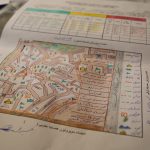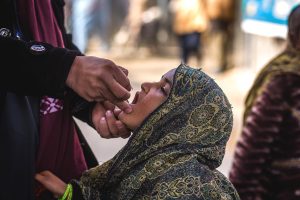
Fast Facts
Population: 37.1M (2018)
- Polio Status: Endemic
- Polio added to the vaccine schedule: 1978 (OPV), 2016 (IPV)
- OPV3 Coverage: 73% (2018)
- IPV Coverage: 66% (2018)
Timeline
1988
The World Health Assembly passes a resolution to eradicate polio by the year 2000, launching the Global Polio Eradication Initiative.
1997
The Acute Flacid Paralysis (AFP) surveillance system is started and national immunization days (NIDs) continue to be conducted. There are 19 reported cases of polio.
2001
35 million children are vaccinated in Afghanistan and PakistanPolio incidence drops to 11 cases in Afghanistan (a 91% reduction comparing to the previous year).
2003
The government of Afghanistan introduces the Basic Package of Health Services (BPHS) program, which includes routine immunization among essential health services.
2006
The President of Afghanistan establishes a National Polio Action Group to oversee the polio eradication effort. Synchronized 'mop up' activities in Afghanistan and Pakistan and immunization campaigns on International Peace Day increase OPV coverage between 2005-2007, still, more than 30 cases are reported in 2008.
2010
5 cases of cVDPV type 2 are detected for the first time in Afghanistan.9 Cases of confirmed WPV are declined by almost 35% (25 compared with 38 cases in 2009). Afghanistan, access to children improved through the use of new tactics, including an enhanced role for NGOs, recruitment of local ‘access negotiators’ and negotiations with the International Security Force and Taliban for ‘days of tranquillity.'
2015
Inactivated Polio Vaccine (IPV) is formally introduced into the routine immunization schedule. National and Regional Emergency Operations Centers are established.
2020
Afghanistan remains affected by wild poliovirus type 1 and circulating vaccine-derived poliovirus type 2, one of 2 remaining polio endemic countries.
Country Data
Afghanistan is one of three remaining polio endemic countries in the world, affected by both wild poliovirus (WPV) and circulating vaccine-derived poliovirus (cVDPV). Although WPV cases have fallen from a peak of 1,991 cases per year in 1983 to just 29 cases in 2019, entrenched implementation challenges, particularly along the Afghanistan-Pakistan border have led to sustained circulation of poliovirus in the area. Ongoing issues related to insecurity, inaccessibility and health systems challenges continue to threaten the achievement of polio eradication.
The Ministry of Public Health (MoPH) plays the lead role in polio eradication efforts in the country, with the overall responsibility to coordinate and communicate with all partners. WHO collects, collates and disseminates standardized information on strategy implementation and impact, particularly in the areas of surveillance and vaccination campaigns, coordination of research, building of capacity and direct operational support to Afghanistan. In Afghanistan, AFP Surveillance System is also operated by WHO. There is a country wide network of AFP Focal Points linked with various health facilities within a district and community-based reporting volunteers. UNICEF leads communication and social mobilization responsibilities for the PEI. UNICEF focuses on reaching children who are most at risk of being missed with oral polio vaccine with the support of thousands of in-country social mobilizers. UNICEF also works with the Afghan government to provide a ‘cold chain’ of storage equipment and refrigerators across the country.
At the national level, the polio program is overseen by the President who Chairs the Polio Steering Committee, responsible for ensuring high-level commitment to polio eradication across the whole of government, and the Presidential Focal Point, who provides day-to-day support for the initiative and chairs the Polio High Council, comprised of the Minister of Health, line ministries and departments, polio staff, and representatives from donor and partner agencies. Beginning in 2015, Emergency Operations Centers at the national and subnational levels were established to intensify, guide and coordinate efforts across all partners according to the National Emergency Action Plan (NEAP). The national EOC governs regional EOCs as well as Regional and Provincial Expanded Program on Immunization (EPI) Management Teams, and NGOs responsible for health service delivery as part of Afghanistan’s public health system, ratified in 2003. To date, the government has relied extensively on external financial support (95% of total budget) to conduct polio and immunization activities.
Organization Description
The Global Innovations Consultancy Services (GLICS), established in 2015 in Afghanistan, focuses on conducting research, capacity development, monitoring and evaluation, and policy formulation for a diverse group of clients. GLICS is committed to working in partnerships with the government, donors, UN agencies, academic institutes, non-governmental organizations, and the private sector in delivering effective evidence-based solutions, as well as ensuring sustainable and integrated capacity building. GLICS provides technical assistance through its in-house specialists and a database of proven international consultants.
GLICS main activities/objectives are as follows:
- Conduct advanced studies and scientific research;
- Organize high-level training courses; organize workshops, conferences and high-level specialized meetings;
- Carry out monitoring of projects and national programs;
- Provide a permanent forum for the elite researchers from Afghanistan and the rest of the world to exchange knowledge, address common concerns and develop and supervise realistic programs; and
- Publish scientific research work, state of the art studies and reports.
Page updated on: 13/09/2020
Key Documents
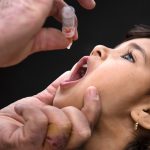
What can over 30 years of efforts to eradicate polio teach us about global health?
View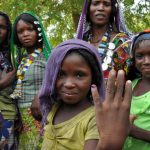
Evaluating the process of partnership and research in global health: reflections from the STRIPE project
View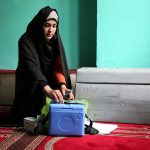
Sampling method for surveying complex and multi-institutional partnerships: lessons from the Global Polio Eradication Initiative
View